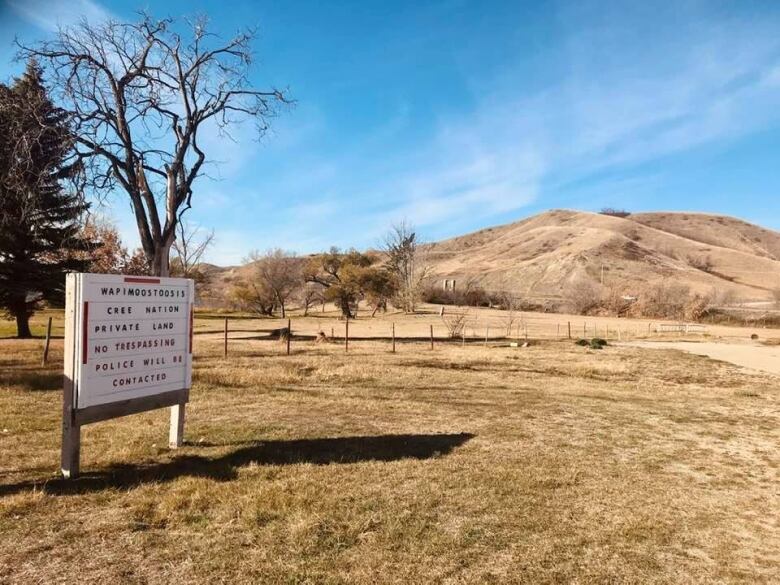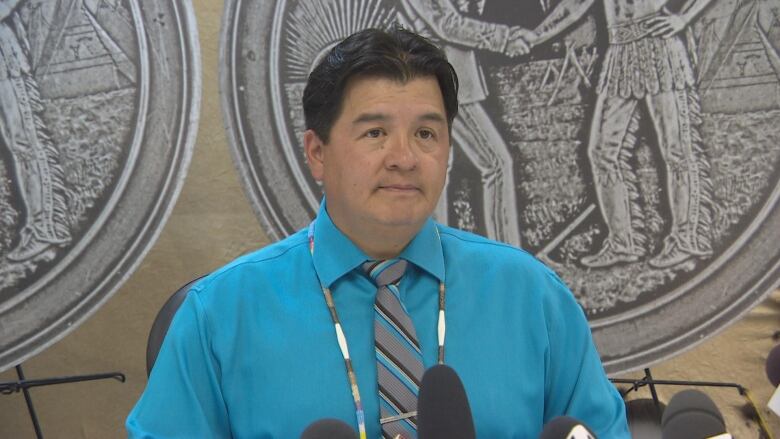Residential school survivors say they should decide location, timing of papal visit
Cowessess First Nation, Tkemlps te Secwpemc, Wanuskewin Heritage Park all raised as possible sites

Wendel Starblanket and A. J. Felix walk the windswept grounds of the former Lebret Indian Industrial Residential School in southern Saskatchewan, imagining what it would be like to host Pope Francis there.
The Roman Catholic-runresidential schoolwas one of Canada's largest. For these two survivors, Lebret is a natural choice for a long-awaited papal apology on Canadian soil.
"The apology should come in the heart of our territories. This is it," said Felix, who was forced to attend the school 500 kilometres south of his home on the Sturgeon Lake Cree Nation.
Last week, after meeting with a Canadian delegation, Pope Francis issued an apology for the actions of some Church members who worked at the schools.
Survivors have been demanding a papal apology on their territory for decades, and these calls were formalized in the 2015 final report of the Truth and Reconciliation Commission. Momentum and pressure grew last summer following the discovery of more than 1,000 unmarked graves, as well as a CBC News investigation revealing new details about the Church's failed compensation efforts.
CBC News interviewed survivors and Indigenous leaders in Saskatchewan and elsewhere. They suggested several locations, including the following.
Lebret

One of Canada's first residential schools to open in 1884, the Lebret Qu'Appelle Indian Industrial Residential School was also one of the last to close,more than a century laterin 1998.
It's located on Wa-Pii Moos-Toosis (White Calf) reserve of the Star Blanket Cree Nation, west of the village of Lebret. A ground penetrating radar search is underway at the site 80 kilometres east of Regina to identify unmarked remains.
Tk'emlps te Secwpemc
In May, 2021, Tk'emlps te Secwpemc leaders announced they'd identified more than 200 possible unmarked burial sites near the site ofthe former Kamloops Indian Residential School.
The announcement triggered widespread outrage and grief, led other First Nations to initiate their own searches or demand release of documents still held by the Roman Catholic Church.
Kukpi7 (Chief) Rosanne Casimir was a member of the recent Vatican delegation and gave Francis a hand written invitation.
Cowessess
In June, leaders of the Cowessess First Nation announced their search had led to the identification of 751 unmarked remain on the grounds of the former Marieval Indian Residential School, the largest of its kind to date.
Prime Minister Justin Trudeau visited the site last year to sign over child welfare responsibilities to the First Nation, located 160 kilometres east of Regina.
Wanuskewin

In 2017, following the TRC's Call to Action, extensive efforts were made to bring Pope Francis to Wanuskewin Heritage Park for the apology.
Located just north of Saskatoon, archaeological records and oral history indicate it's been a gathering place for Indigenous people for thousands of years. While it's not a First Nation or Catholic residential school site, several are nearby, including St. Michael's Indian Residential School.
Lac Ste. Anne
Located northwest of Edmonton, Lac Ste. Anne was raised by Pope Francis when he spoke to the delegation. An annual pilgrimage in late July now draws thousands to the lake for masses and spiritual events in Engligh, Cree and other languages.
First called Wakamne (God's Lake) by the Alexis Nakota Sioux Nation and Manito Sahkahigan (Spirit Lake) by the Cree, the name was changed to "Lac Ste Anne" by the Catholic priest who established a mission on the site in the mid-1800s.
However, some survivors interviewed say any apology must be issued to all survivors, not just those who have chosen to remain Catholic. Some would not feel comfortable attending a traditionally Catholic event.
Leaders agree on other key points
There were different opinions on location for a papal visit, but there was general agreement on four other points.
First, any further apology must acknowledge the complicity of the entire Catholic Church and Vatican, not just some individuals.
"It was the whole Church. The whole Church hurt our people. When [Francis] said 'some people,' that threw me back a bit," Felix said.
Second, action must accompany any apology. This includes disclosing all documents on the schools and graves, as well as full payment of compensation which some estimate to be more than $60 million. It also includes repatriation of artifacts, repudiation of the colonial Doctrine of Discovery, and prosecution and extradition of abuser priests.
Church officials say talks are underway, but Pope Francis did not mention any of these issues in his apology and speech to delegates.
"It doesn't really feel good to hear that [apology]when they haven't even addressed the outstanding issues. It's just another way to talk to us with a forked tongue," Starblanket said.
Thirdly, all expenses roughly $50 to $100 million for previous papal visits should be paid entirely by the Vatican. Any money from taxpayers or Canadian Catholics should instead go directly to programs for survivors and their descendants.
"The Vatican is worth billions. They should pay. It's time to right the wrongs, and they can start with this," said Federation of Sovereign Indigenous Nations Chief Bobby Cameron.

Finally, the location, timing and all major decisions should be made by survivors themselves.
"For all of this to resonate with the survivors and allow us to move forward, the survivors have to feel they are a fundamental part of this historic process," said Grand Chief Stewart Phillip of the Union of British Columbia Indian Chiefs.
"For survivors to decide the where, how, what, when and why, it puts more trust into the whole journey," Cameron said.
CBC News requested an interview with Crown-Indigenous Relations Minister Marc Miller to ask if the federal government will be financing Pope Francis' trip, but an official said Miller was not available.
Canadian Conference of Catholic Bishops official Jonathan Lesarge said "meaningful discussions" are underway with the federal government and Indigenous people. He said more details should be available soon.
"As Catholics we believe in the restorative power of apologies, but acknowledge that the apologies from both Canada's Bishops and Pope Francis are only one step in the ongoing journey towardhealing and reconciliation, and must be accompanied by concrete measures," Lesarge wrote in an email.
Back at the Lebret school site, A. J. Felix and Wendel Starblanketsay they have to get going. That afternoon, they're overseeing a sweat lodge ceremony for PeepeekisisCree Nation members, helping them to reconnect to their spirituality.
"These schools were a direct attack on our culture, on our family units. It hurt us bad. Now we're trying to get that back," Felix said. "So when you hurt someone, you apologize. But you also try to make it right."












_(720p).jpg)


 OFFICIAL HD MUSIC VIDEO.jpg)
.jpg)



























































































